Thomas Blunt (1739~45 - 1823)
Charles Blunt (1775 - after 1853)
Thomas Blunt, Jr. (1789 - after 1823)
Edward Blunt (1798 - 1826)
T. Blunt, Blunt & Son, T. & T. Blunt, and E. Blunt
by Brian Stevenson
last updated January, 2023
Seven years after completing his apprenticeship with Edward Nairne (1726 - 1806), Thomas Blunt formed a partnership with his former master, which lasted from 1774 until 1793. Blunt then separated and opened his own shop, two doors down from Nairne. Over the next three decades, Thomas Blunt trained, then formed partnerships with, three of his sons. The business was intermittently known as “T. Blunt” and “Blunt and Son”. Instruments signed “T. & T. Blunt” date to the period when Blunt partnered with son Thomas Jr., from 1811 until ca. 1820. After Thomas Blunt Sr.’s death, son Edward inherited the business and continued as “E. Blunt”. Examples of microscopes produced by Thomas Blunt and his various partners are shown in Figures 1-6. Other optical and scientific instruments manufactured by Blunt and partners are shown at the end of this essay, as Figures 23-26.
In researching the Blunt business and family history, I came across many examples of incorrect dates, names, and addresses. Those mistakes were presumably results of relying on secondary sources for information, where errors persist and amplify. Where possible, I have used primary sources to compile this history. When a secondary source was required, caveats are noted.
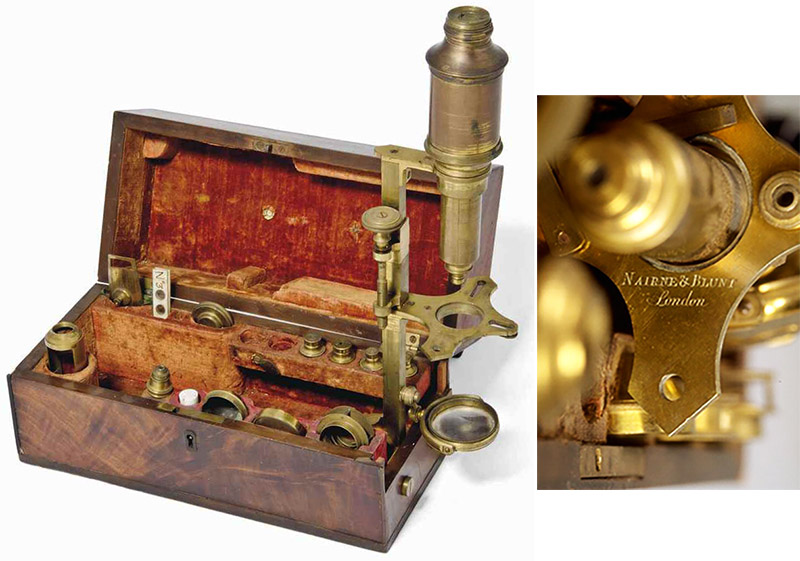
Figure 1.
Chest microscopes, signed “Nairne & Blunt”, circa 1774-1793. Edward Nairne is credited with developing this pattern of microscope. Images used for nonprofit, education purposes. Left image from an internet auction site, right image from https://ar.utmb.edu/ar/Library/BlockerCollections/BlockerHistoryofMedicineArtifacts/MicroscopeCollection/MicroscopesMakersandTheirInstruments/MicroscopeNairne/tabid/870/Default.aspx.
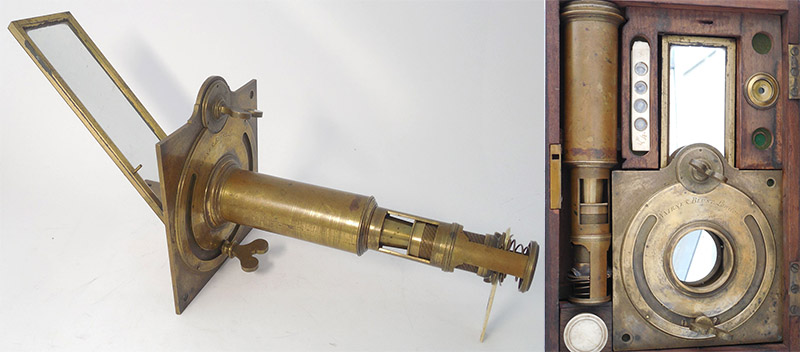
Figure 2.
A solar microscope, signed “Nairne & Blunt”, circa 1774-1793. Images generously provided by Horst Kuhn, http://kuhn-scientificinstruments.de/microscope-types.
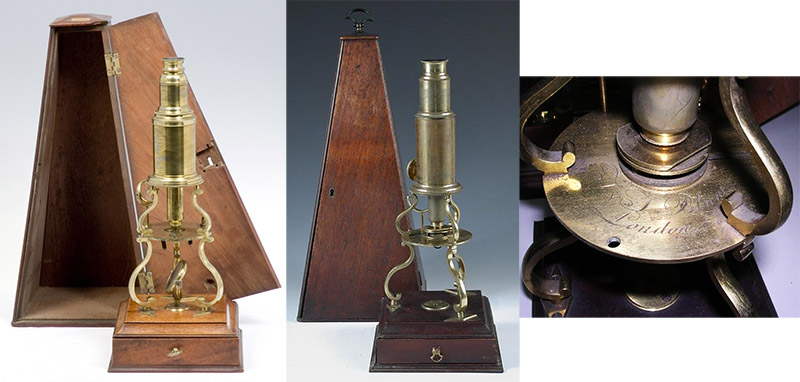
Figure 3.
Two Culpeper-style microscopes. The left example is signed “Nairne & Blunt”, ca. 1774-1793, and the right one is signed “T. & T. Blunt”, circa 1810. Adapted for nonprofit, educational purposes from (left) http://www.mhs.ox.ac.uk/collections/imu-search-page/record-details/?thumbnails=on&irn=5747&TitInventoryNo=41792, and (right) an internet auction site.
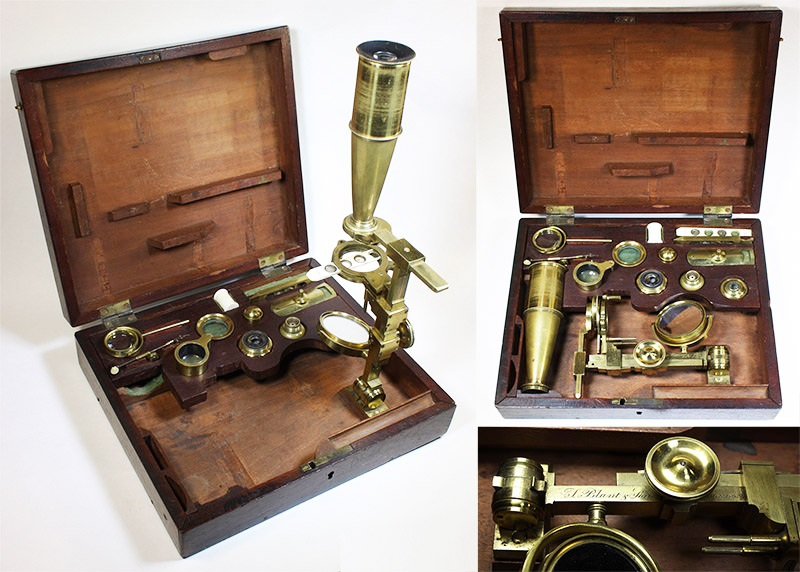
Figure 4.
A case-mounted microscope, signed “T. Blunt & Son”, circa 1801-1823. The Golub Collection includes a similar microscope that is signed “T. Blunt”, but includes a trade card from “T. Blunt & Son”: http://golubcollection.berkeley.edu/19th/171.html.
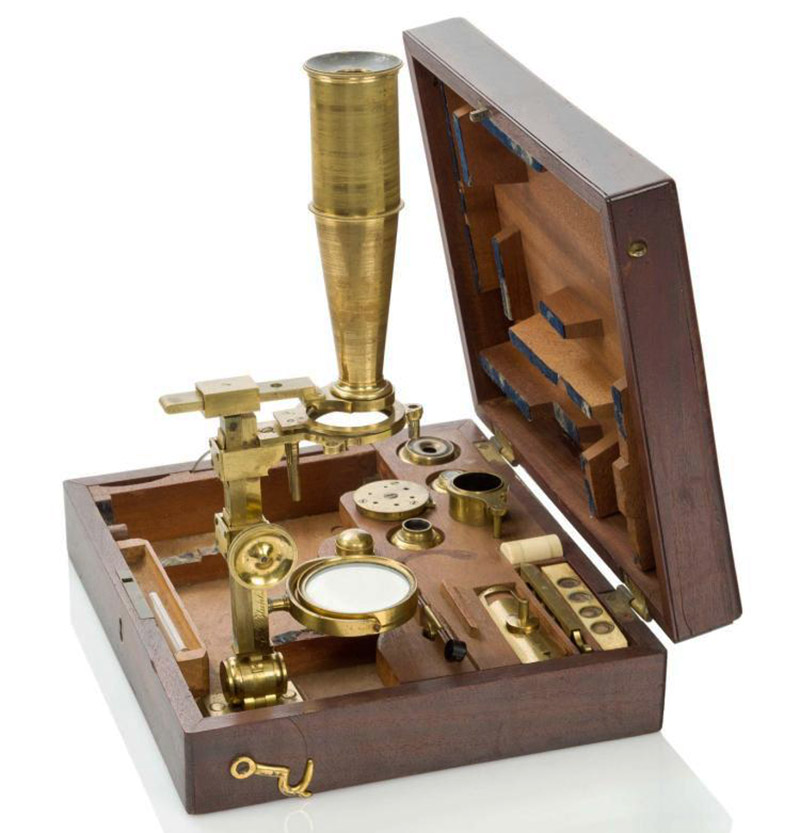
Figure 4-B.
The same model of microscope as shown above in Figure 4. It is signed “E. Blunt”, indicating production after Thomas’ death, by his son and heir, Edward. The son died soon after his father, and was in business from only 1823 until 1826. Adapted for nonprofit, educational purposes from an internet auction site.
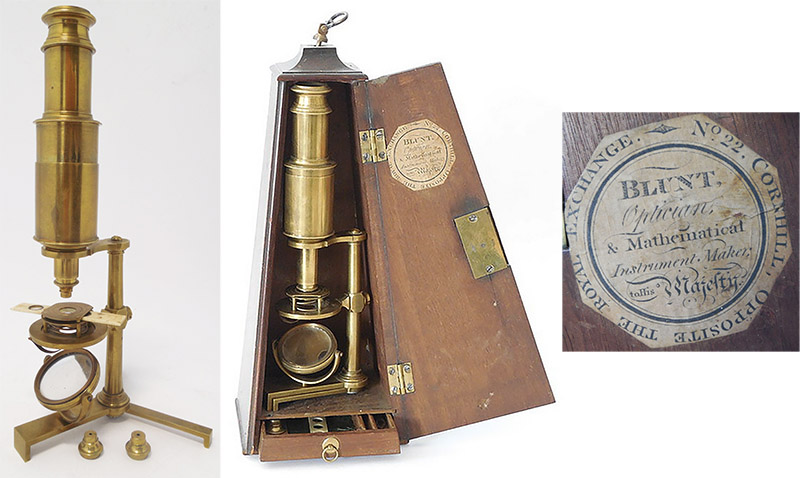
Figure 5.
A tripod-based microscope, bearing a label from “Blunt”. This instrument shares several features with Carpenter’s “New Improved” microscopes. Images generously provided by Horst Kuhn, http://kuhn-scientificinstruments.de/microscope-types.
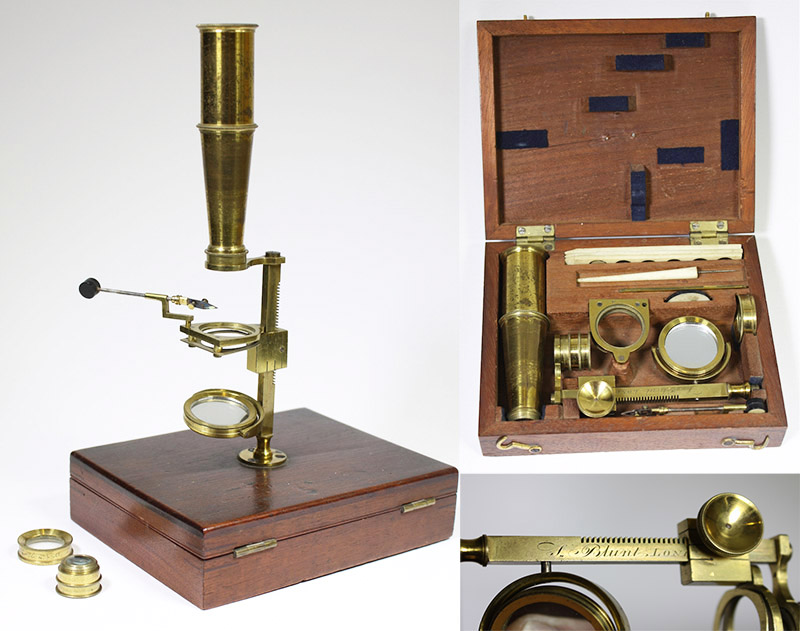
Figure 6.
A case-mounted microscope, signed “T. Blunt”. Since Thomas Blunt died in 1823, this instrument was manufactured at least 3 years before Charles Gould and William Cary began selling what has become known as the “Cary-Gould” model. It should be noted that Gould’s 1826 invention was a compact microscope in which the stem screws into the inside edge of the case, although the term “Cary-Gould” has been expanded to include any similarly-shaped microscope that screws into any part of its wooden case. This Thomas Blunt microscope demonstrates that many features of the “Cary-Gould” were used in earlier instruments, and were made by other manufacturers.
According to Thomas Blunt’s January, 1860 apprenticeship contract, his father, William, was a shoemaker in Barnes, Surrey (Figure 7). Thomas’s birthdate has yet to be discovered. His burial record stated that he was 83 years old when he died on March 16, 1823, giving a birth year of 1739 or 1740. An obituary gave his age as 84. Yet, those dates would mean that Thomas was 20-21 years old when he began his apprenticeship, which is rather late in life. A more common age would be 15 or so, suggesting a birth date of around 1844-1845.
Two of Blunt’s sons, Edward and William, became members of the Spectacle Makers’ Guild as consequences of their father’s membership. According to their admission papers, Thomas Blunt became a Guild Member in 1769.
The next identified record of Blunt’s life is the December 20, 1773 marriage contract between Thomas and the father of Mary Moys Fly (Figure 8). Mary was then 19 years old, and, as a minor, required her parents’ permission to marry. The contract states that Thomas Blunt was a resident of Tooting, Surrey. He may have operated an business in that town during the seven years between the end of his apprenticeship and the beginning of his partnership with Nairne.
Thomas and Mary married on January 6, 1774, at the Tooting Parish Church. Edward Nairne signed the parish record as a witness (Figure 9).
According to Gerard l’E. Turner, Edward Nairne and Thomas Blunt formed their famous partnership in 1874. Nairne was already established at 20 Cornhill, across the road from the Royal Exchange, and the partners continued business at that location.
Thomas and Mary’s son, Charles Fly Blunt, was born April 28, 1775. There do not appear to have been any other surviving children. Mary died between 1775 and 1788, when Thomas Blunt “widower”, married Margaret Fenn (Figures 10 and 11). Since a major task of a wife in those days was to tend the children, Thomas’ remarriage in 1788 suggests that Mary died only a short time before then.
Thomas and Margaret had 7 children: Thomas (born July 28, 1789), Elizabeth (born February 28, 1791), Henry (baptized April 28, 1793), Martha (baptized June 15, 1794), Edward (born January 11, 1798), William (born December 25, 1799), and Ann (born January 24, 1802). All except Henry were mentioned in Thomas’ will, and there are no further records of that boy, suggesting that the son died young. Thomas Jr. and Edward trained with their father, and both were involved in family partnerships. William appears to have trained with his father to some extent (he became a member of the Spectacle Makers’ Guild), but followed an academic and clerical path to become a well-regarded teacher at Merchant Taylors’ School.
Thomas Blunt served as Master of the Spectacle Makers’ Guild in 1792 and 1815.
Blunt’s prestige in the optical community, evident by his elevation to Master in 1792, may have prompted him to split with Nairne and form his own company. The partnership was dissolved on July 24, 1793 (Figure 12). Blunt opened a shop two doors down from Nairne, at 22 Cornhill (Figures 13 and 14). It is not known how the relationship fared between the two former partners, who remained neighbors until Nairne retired in 1801.
By 1794, Thomas had acquired the honor of “Mathematical Instrument Maker to His Majesty”.
As noted above, Thomas Blunt worked in partnership with at least three of his sons. The durations of those “Blunt and Son” businesses are not precisely known. No advertisements from Thomas are known. Business directories alternating refer to the shop at 22 Cornhill as with and without a son, and were inconsistent: in 1822, Pigot’s Directory listed “Blunt Thos. and Son, 22 Cornhill”, while The History, Directory & Gazetteer listed “Blunt, Thomas, 22, Cornhill”. It is unlikely that directory publishers canvassed every business every year to see if there had been any minor name changes. Available records indicate the following:
Blunt and Son: Charles Blunt
Christ’s Hospital received deliveries from “Blunt and Son” in 1801, according to Gloria Clifton’s Directory of British Scientific Instrument Makers 1550-1851. Eldest son Charles was then 25 years old, while the second eldest son, Thomas, had not yet begun his apprenticeship. Later advertisements from Charles state that he had worked from 22 Cornhill (Figure 15). By 1811, Charles opened his own shop at 38 Tavistock Street, Covent Garden, when he published An Essay on Mechanical Drawing from that address (Figure 16). Thus, the first iteration of “Blunt & Son” undoubtedly consisted of father Thomas and son Charles, extending from roughly 1801 until 1811.
Charles pursued many other endeavors. As did also his father, Charles wrote weather reports for several magazines. He was awarded a patent in 1812 “for certain improved arrangements of machinery for the improvement of ship fire hearths, and an extension of the same to other useful purposes”, and in 1853 applied for a patent for “an improved artificial fossil coal-fuel, which he desires to denominate ‘Blunt's diamond coal-fuel’.” In 1815, “Mr. Elmes, the architect, has invented a new instrument, which delineates perspective views with mathematical precision, and is so simple in its nature and construction, as strongly to recommend it to architects, painters, and sculptors; and the practitioners and students in every department of the fine arts. With its assistance, architectural views may be delineated, with unexampled celerity; and even those difficult subjects, to which, on account of the variety of their forms and appearances, the practical rules of perspective are so seldom applied, as the foreshortenings of the human figure, and indeed every natural appearance whatever. For the purposes of popular instruction in astronomy, the relative distances of stars from each other can be measured by it, and the progress of planets, comets, &c. ascertained and delineated. Mr. Elmes has appointed an intelligent artist and mathematical instrument maker, Mr. Charles Blunt, of Tavistock Street, Covent Garden, to make and vend them, who will shortly have them ready for sale, with a descriptive pamphlet by the inventor”.
Charles Blunt filed for bankruptcy protection on his optical and scientific business on Tavistock Street in August, 1818 (Figure 17). I did not find any further records of Blunt operating a similar business.
Charles was next involved with several different types of businesses, but was again declared insolvent in 1837. An announcement of that bankruptcy gives a view of some of his occupations, and of his frequent moves: “Charles Fly Blunt (sued as Charles Blunt), formerly of No. 47, Upper York-Street, Bryanstone-Square, Middlesex, then of the Wandsworth-Road, Surrey, Clerk to a Bronzist, afterwards of Tonbridge-Wells, Kent, Engineer, then of No. 3, Mornington Place. Hampstead-Road, then of No. 51, Great Ormond-Street, afterwards of No. 14, Claremont-Place, Upper Islington, all in Middlesex, Editor and Manager of a work called the Civil Engineer, then of No. 26, Hatton Garden, Middlesex, Civil Engineer, and late of No. 84, Hercules-Buildings, Lambeth, Surrey, out of business”.
In 1840, Charles published a popular book on astronomy, The Beauty of the Heavens, and evidently presented lectures based on that material. The 1841 census described Charles as being a “civil engineer”, and a widower, living with two people who were probably his children (the 1841 census did not record relationships): Blanch Blunt (born ca. 1815) and Felix Blunt (born ca. 1821). Charles was involved with several financial schemes over the next several years, including a railway, an artesian water company, and the aforementioned artificial coal business. His 1853 patent application is the last known record of Charles Blunt.
Blunt and Son / T. and T. Blunt: Thomas Blunt, Jr.
Thomas Jr. joined his father as an apprentice on March 1, 1804 (Figure 18). The Webster Signature Database states that he became free of the Spectacle Makers’ Guild on March 2, 1811, the end of his proscribed seven years of apprenticeship. He was probably not considered to be a partner until after completion of the apprenticeship, and was probably brought on board around the same time as Charles left. The duration of the Thomas Sr. and Jr. partnership is not known, although the large number of instruments signed “T. & T. Blunt” suggests a period of several years. Thomas Jr. and his wife, Anne, baptized daughter Anne Elizabeth on August 18, 1817, at the St Leonard Foster Lane parish church. The parish record states that he was an “optician”, living at Ivy Lane. The Webster Signature Database further describes the address as 18 Ivy Lane. This appears to have been a walkable distance to Cornhill, so he may have still been in partnership with his father. However, the terms of Thomas Sr.’s 1823 will imply that Thomas Jr. was no longer part of the business (Figure 19). Thus, the partnership of Thomas Blunt Sr. and Jr. probably lasted from around 1811 until the end of that decade. I have not found any records of Thomas Jr. after the mention in his father’ will.
Blunt and Son: Edward Blunt
Clifton reported that Edward began an apprenticeship with his father in 1813, and so would have been freed in 1820. The first firm record of Edward partnering with his father is a court transcript of a theft of “twelve sets of drawing instruments, value 36s, the goods of Thomas Blunt and Edward Blunt”, which took place on January 18, 1823 (the 12 year-old snatch thief was convicted and sentenced to seven years “transportation”).
Thomas Blunt’s will left his shop to Edward (Figure 19). In contrast, sons Charles and Thomas only received £5 each.
Within half a year of inheriting the business, Edward filed for bankruptcy and sold off a substantial amount of his stock and machinery (Figures 20-22). His father’s will required payments of large sums to his other children (Figure 19), so the bankruptcy and auction probably served to raise those funds. Despite his losses, Edward remained in business at the same location until 1826.
Although the 1825 Pigot’s Directory listed the 22 Cornhill business as “Blunt Thos. & Son”, it is possible that the directory compilers did not include minor name changes. As noted above, two different directories listed the business under different names in 1822. The Golub Collection holds a microscope that is engraved “E. Blunt”, indicating that Edward used his own name for the business after Thomas’ death.
Edward Blunt died in 1826, when only 28 years old, and was buried on September 22 at the St. Michael Cornhill parish church. Clifton wrote that Edward’s widow, Lydia, applied to the Spectacle Makers’ Guild for charity shortly thereafter.
The business at 22 Cornhill was sold ca. 1827 to Thomas and William Harris, of the established optical and scientific business T. Harris and Son. On June 28, 1828, the two Harrises separated, with William Harris taking 22 Cornhill, and Thomas Harris retaining the firm’s old location at 52 Great Russell Street. William Harris left 22 Cornhill in 1835.
Final biographical notes
Thomas Blunt Sr. died on March 18, 1823. He was buried in “the New Vault, North Aisle” of the St. Michael Cornhill parish church. His second wife, Margaret, died the next year, and was buried alongside Thomas on July 19, 1824.
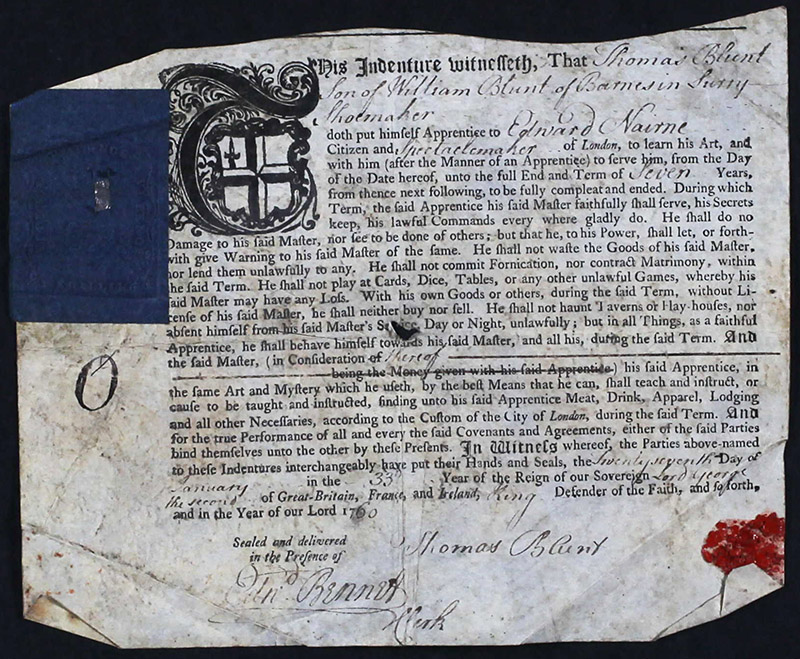
Figure 7.
The 1860 contract that committed Thomas Blunt, “Son of William Blunt of Barnes, Surrey, Shoemaker”, to a seven-year apprenticeship with Edward Nairne, “Citizen and Spectaclemaker of London”.
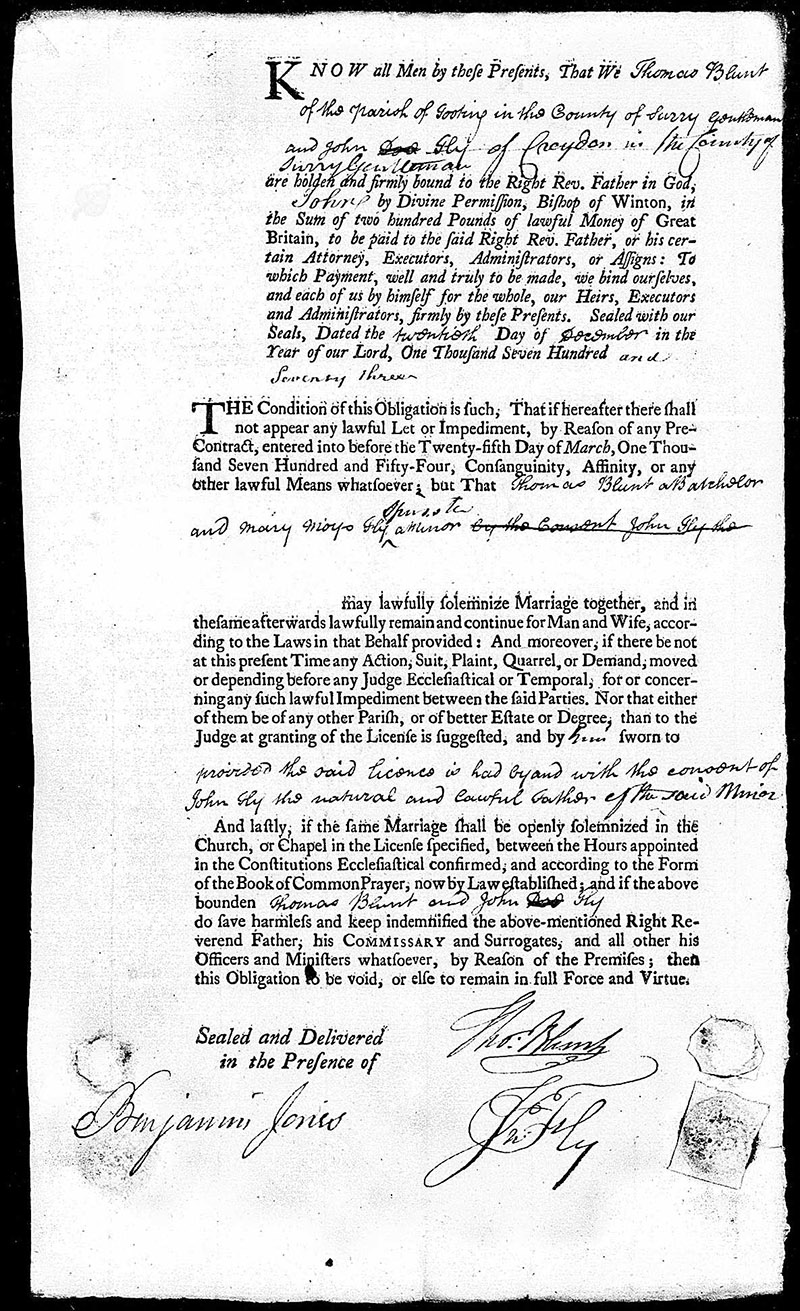
Figure 8.
The December 20, 1773 marriage agreement between Thomas Blunt and John Fly, father of Mary Moys Fly.
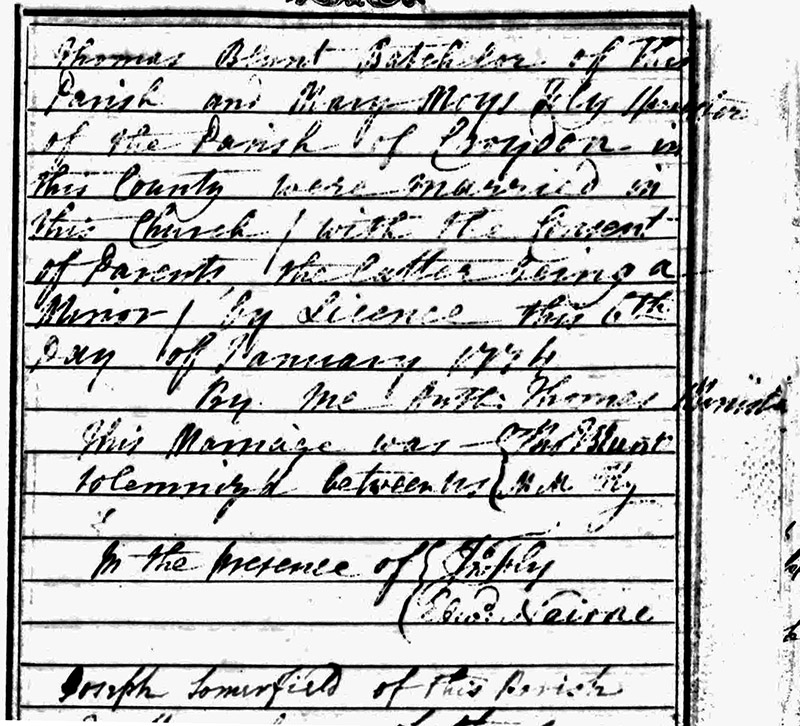
Figure 9.
Parish Church record of the marriage of Thomas Blunt and Mary Moys Fly. Edward Nairne signed as a witness.
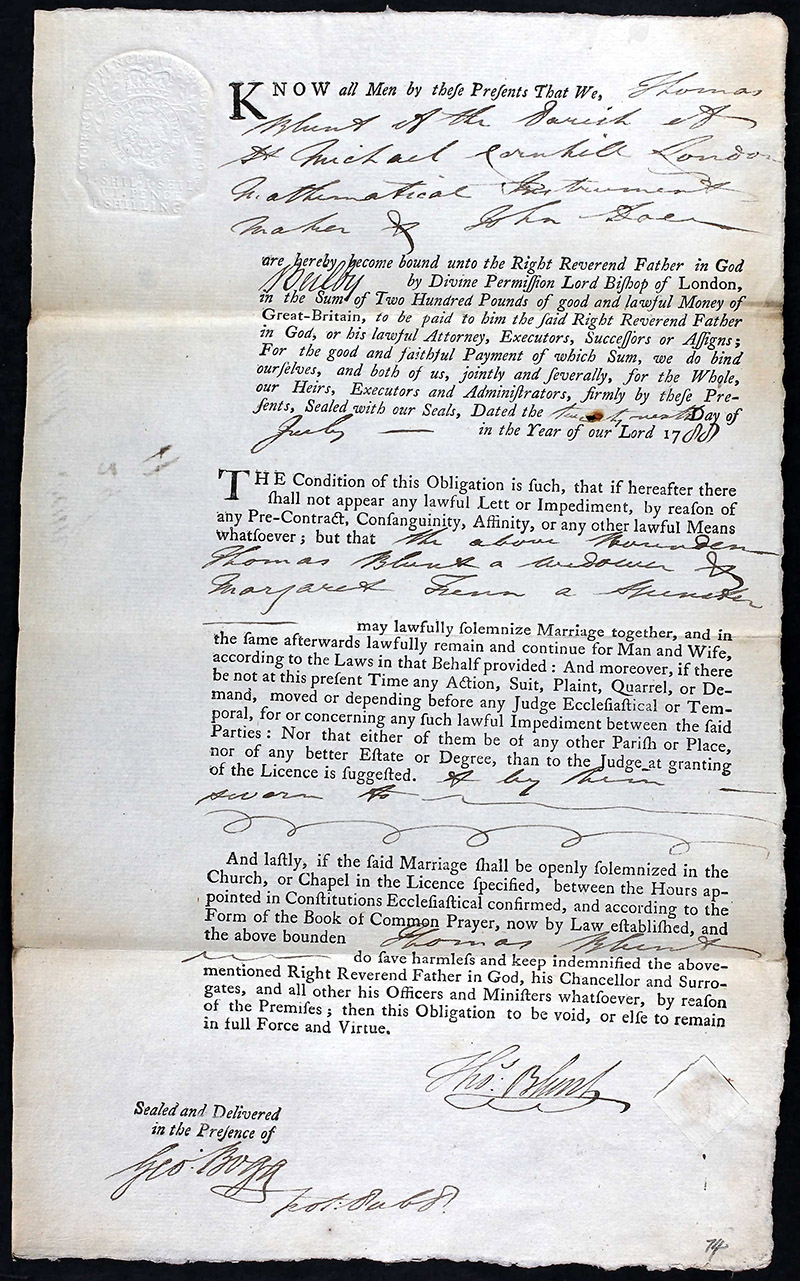
Figure 10.
The 1788 marriage agreement between Thomas Blunt, “mathematical instrument maker …a widower”, and John Fenn, father of Margaret Fenn.
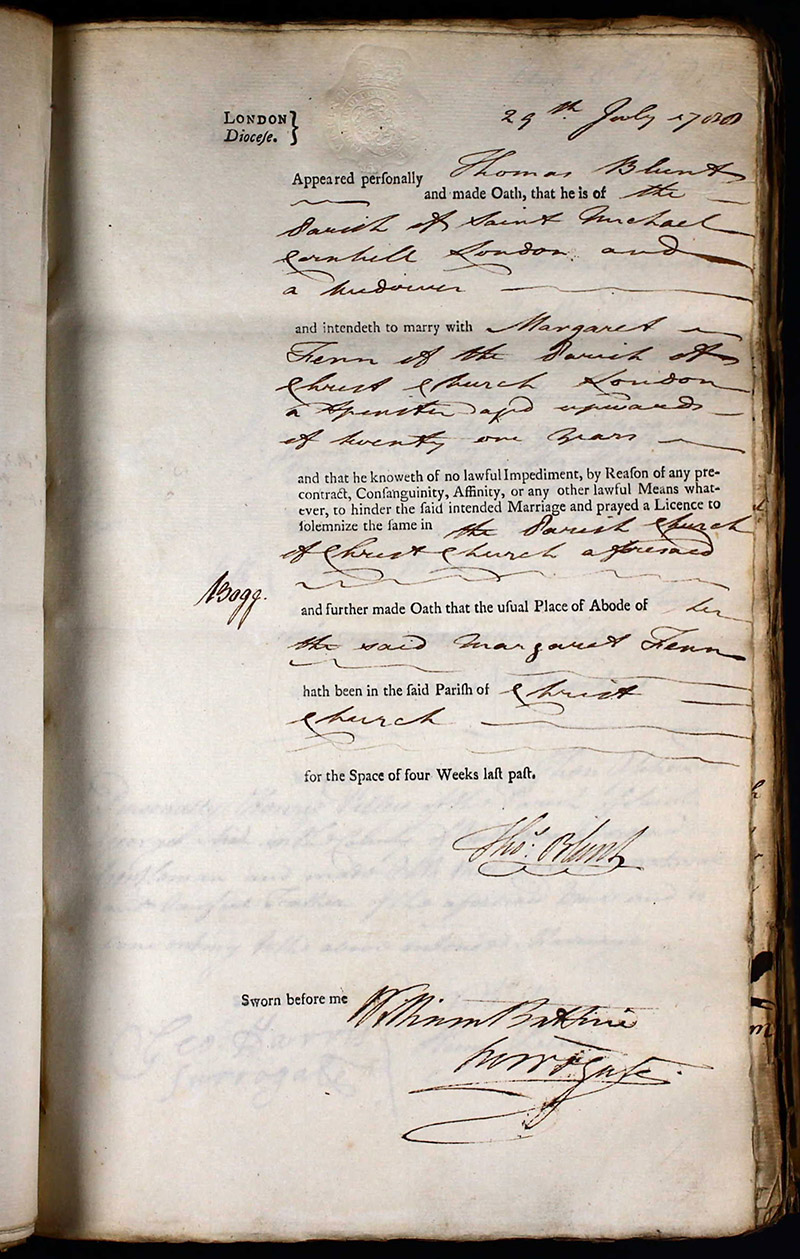
Figure 11.
The parish record of the July 29, 1788, marriage of Thomas Blunt and Margaret Fenn. Blunt signed the record, beneath the type printing.
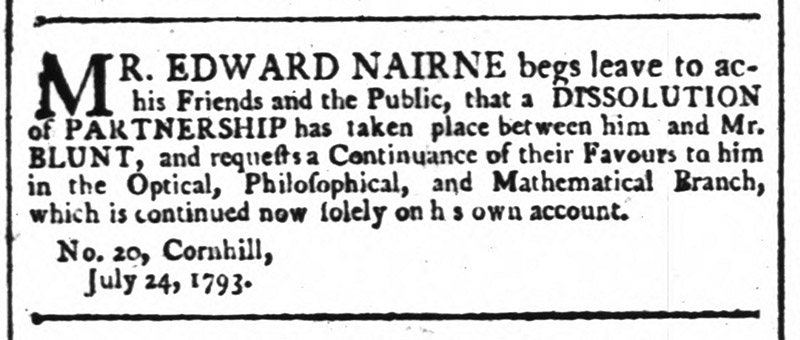
Figure 12.
Notice that the partnership of Nairne and Blunt was dissolved on July 24, 1793. Published on page 1 of ‘The Times’ (London), August 2, 1793.
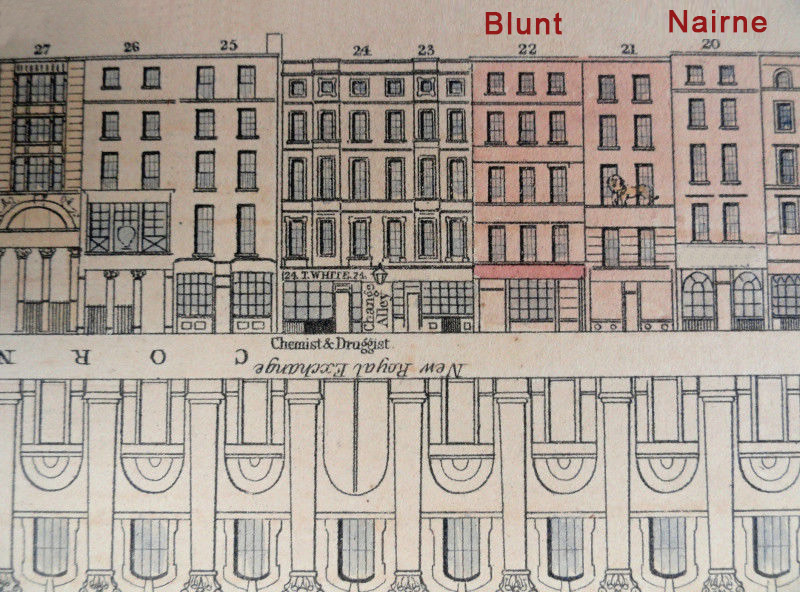
Figure 13.
Diagram of both sides of Cornhill, showing numbers 22 and 20, which were occupied by the optician shops of Thomas Blunt and Edward Nairne, respectively. Picture adapted from “John Tallis's London Street Views, 1838-1840”.
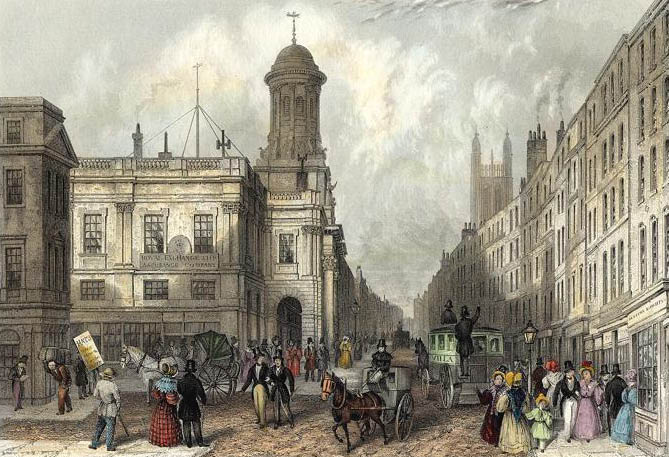
Figure 14.
T.H. Shepherd’s “Royal Exchange and Cornhill”, 1837. The area probably looked much like this when Thomas Blunt was alive. From this view, Blunt’s shop, number 22, was on the right side of the street, a short distance beyond the green carriage.

Figure 15.
A four-page 1816 advertisement from Charles Blunt. His advertisements from other years also mentioned that he was “formerly of Cornhill”, probably attempts to attract the attention of customers who were familiar with his better-known father. Note that Charles made and sold eyeglasses, telescopes, magic lanterns, books, and many other items.
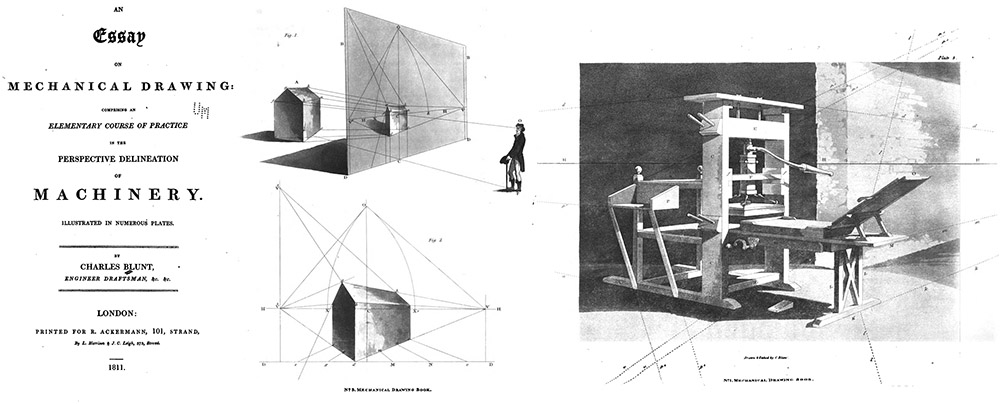
Figure 16.
Title page and excerpts from Charles Blunt’s 1811 ‘An Essay on Mechanical Drawing’. Figures throughout the book indicate that Charles was a keen mechanical illustrator.

Figure 17.
Charles Blunt filed for bankruptcy on his optical and scientific business in 1818.
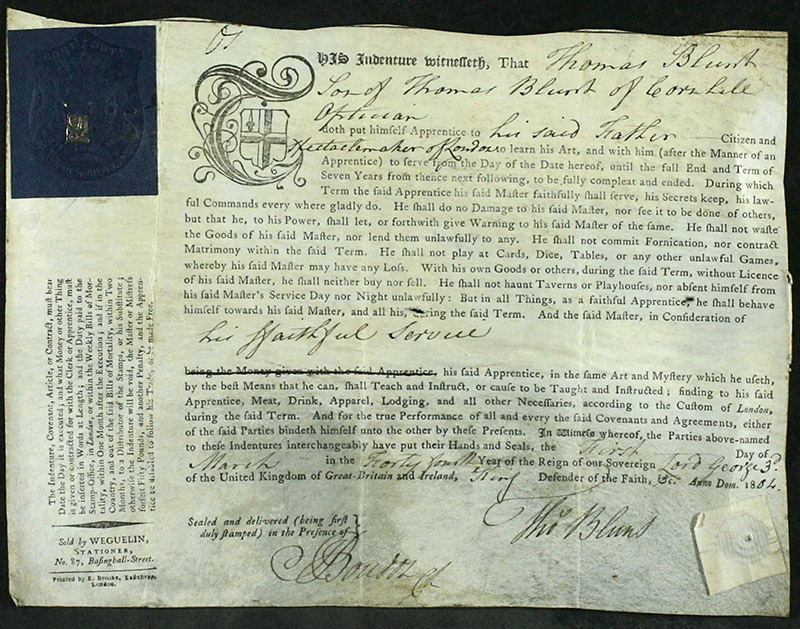
Figure 18.
The apprenticeship contract of Thomas Blunt, Jr., signed March 1, 1804.

Figure 19.
Transcript of the will of Thomas Blunt, proved on April 28, 1823.
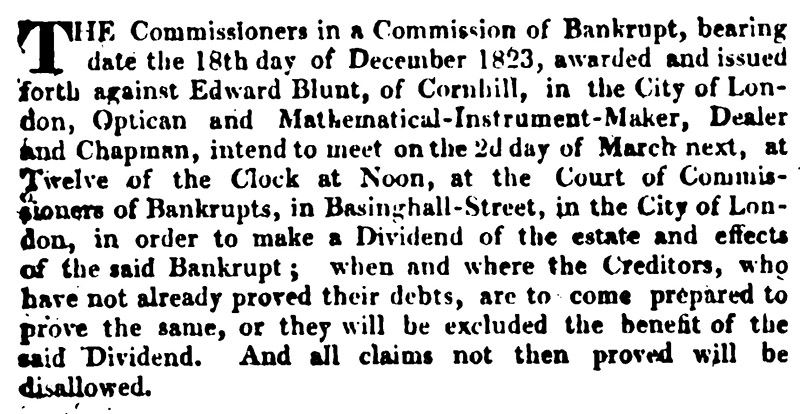
Figure 20.
Edward Blunt filed for bankruptcy in December, 1823.

Figure 21.
Notice of the February 9, 1824, auction of Edward Blunt’s stock and equipment, to raise funds for compensation of his creditors.
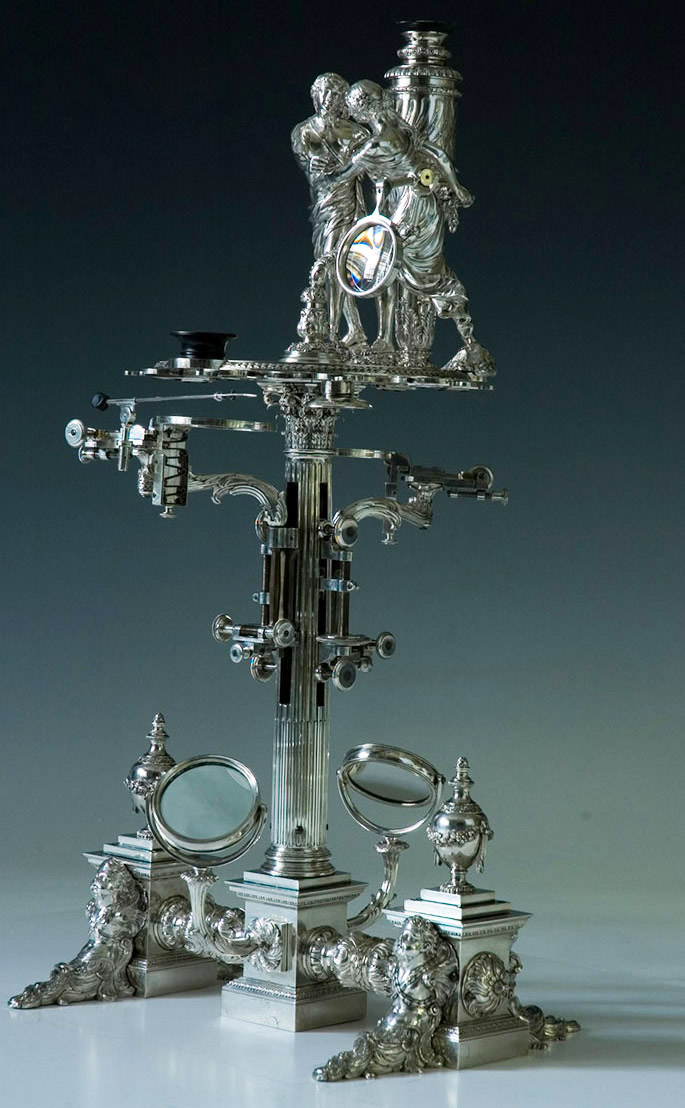
Figure 22.
The silver microscope that was made for the future King George III by George Adams circa 1763. The notice of the auction of Edward Blunt’s property (Figure 21) implies that this microscope was once owned by Thomas Blunt. Adapted for educational, nonprofit purposes from http://oxuni.museum/mhs/top-objects/king-george-iii%E2%80%99s-microscope.
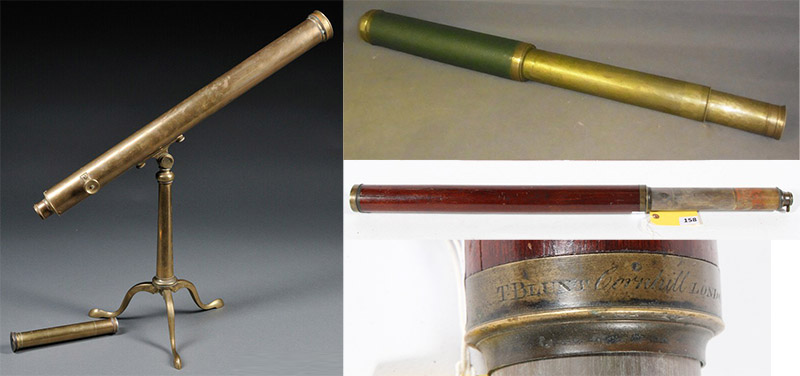
Figure 23.
Three telescopes, all signed “T. Blunt”. Adapted for nonprofit, educational purposes from internet auction sites.
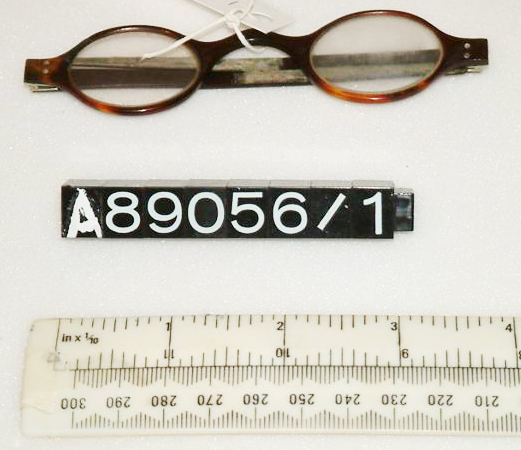
Figure 24.
A pair of eyeglasses, produced by T. and T. Blunt. Adapted from http://collectionsonline.nmsi.ac.uk/detail.php?type=related&kv=8057623&t=objects.
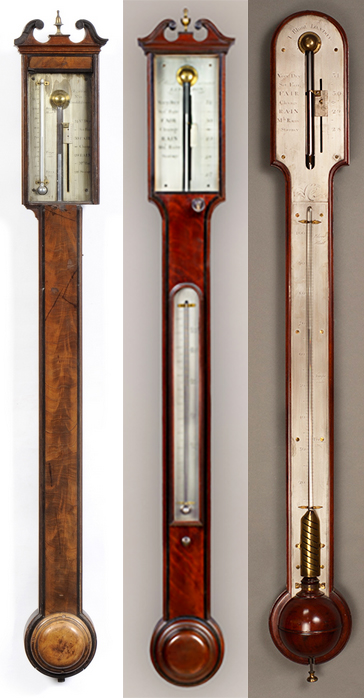
Figure 25.
Three barometers that were produced by T. Blunt. Adapted for nonprofit, educational purposes from internet auction sites.

Figure 26.
Mathematical and engineering instruments. Left to right: folding protractor signed “Blunt & Son”; proportional dividers signed “T. Blunt”; sectors signed “T. Blunt” (above) and “T. and T. Blunt” (below); and a cased set of instruments, signed “T. Blunt. Adapted for educational, nonprofit purposes from and internet retail site and http://www.mathsinstruments.me.uk/page35.html, http://www.mathsinstruments.me.uk/page65.html http://www.mathsinstruments.me.uk/page89.html
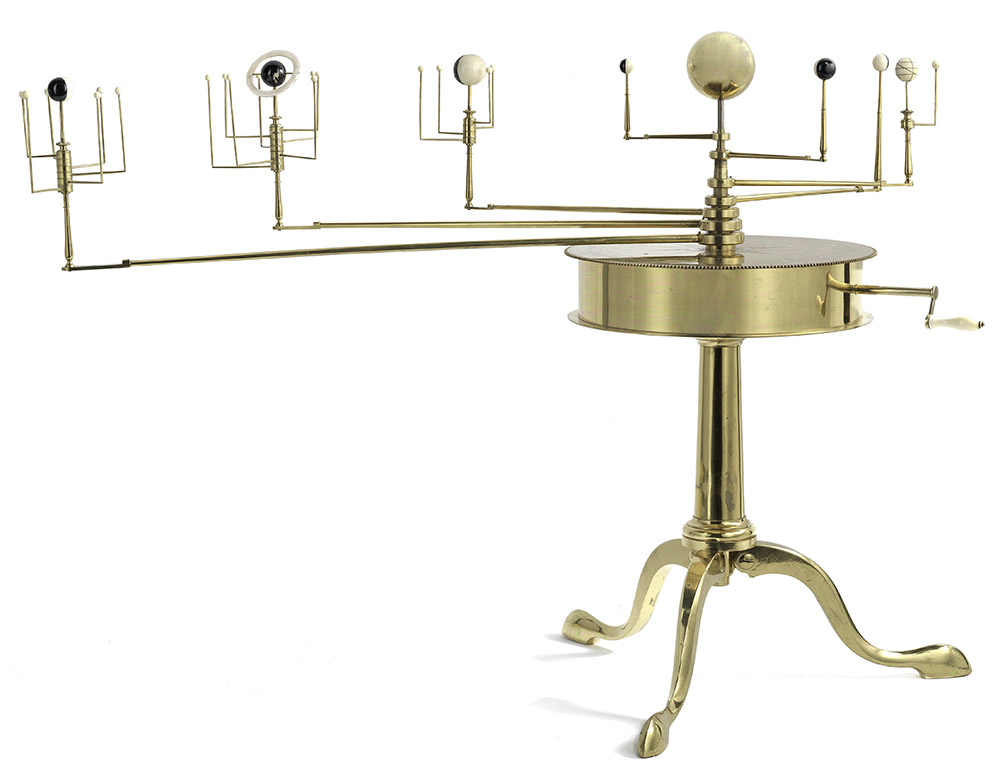
Figure 27.
A circa 1800 combined planetarium, lunarium, and tellurium, signed "T. Blunt. London". Adapted for nonprofit, educational purposes from an internet auction site.
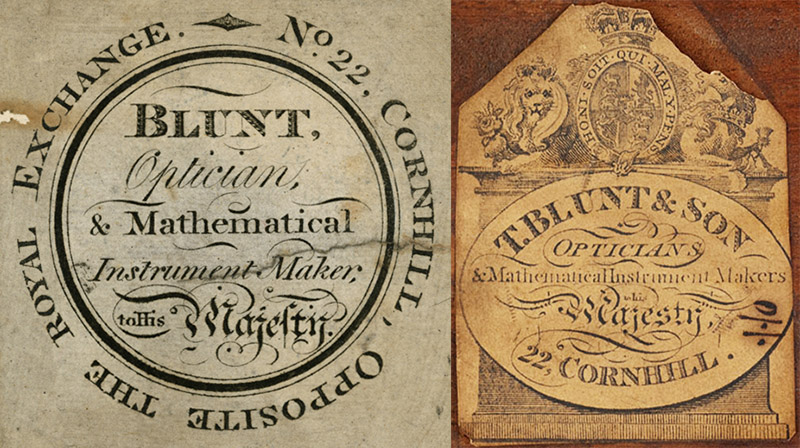
Figure 28.
Trade labels from Thomas Blunt / Blunt and Son. Adapted for nonprofit, educational purposes from http://collectionsonline.nmsi.ac.uk/detail.php?type=related&kv=8002716&t=objects and http://golubcollection.berkeley.edu/19th/171.html.
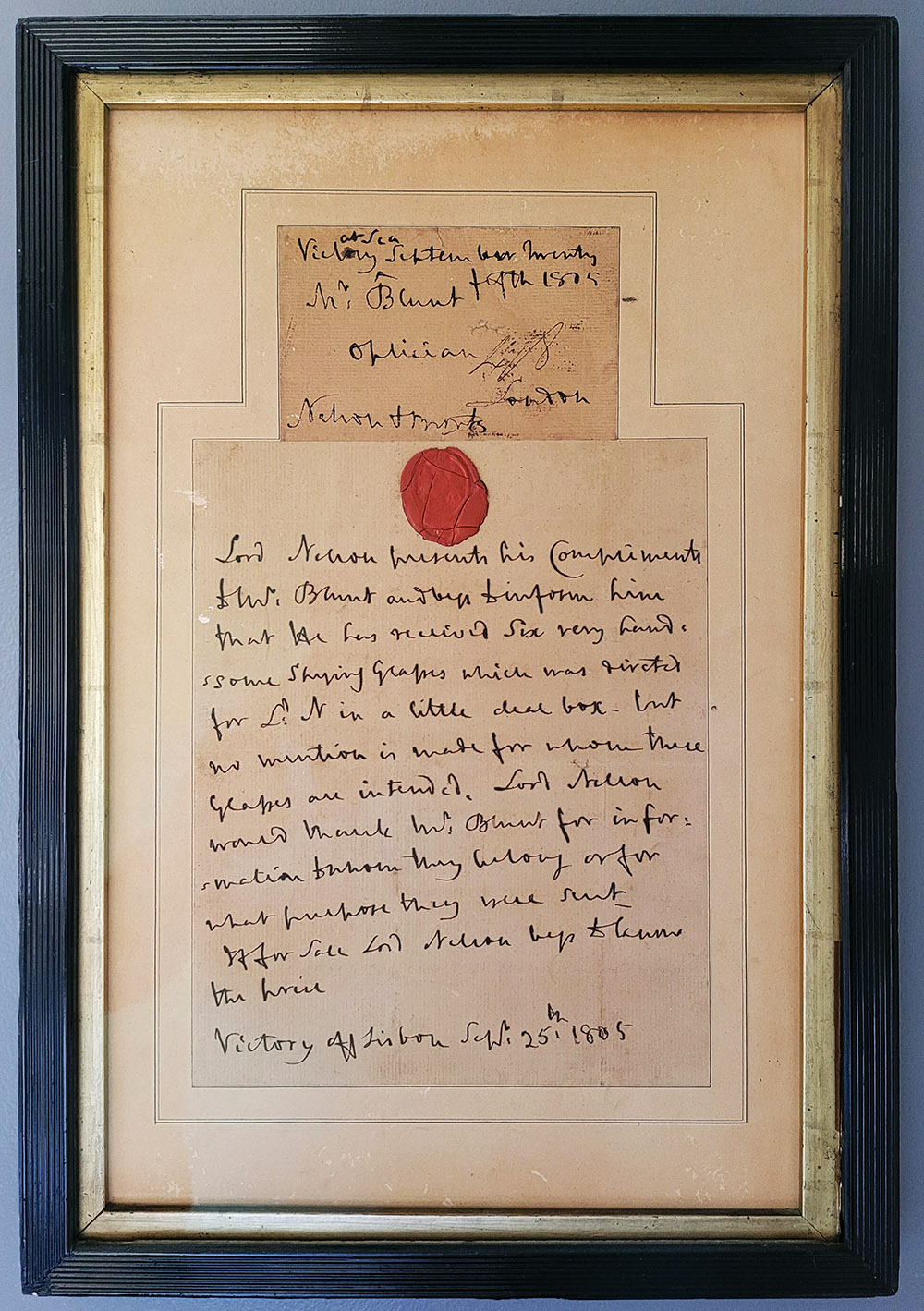
Figure 29.
A letter from Horatio Nelson to Thomas Blunt, dated September 25, 1805, inquiring about a delivery of telescopes from Blunt. Image graciously provided by Rob Hewitt.
Acknowledgements
My thanks to Joe Zeligs, Horst Kuhn, and Rob Hewitt for generously sharing critical information and pictures.
Resources
Blunt, Charles (1811) An Essay on Mechanical Drawing, R. Ackerman, London
Blunt, Charles (1840) The Beauty of the Heavens, Whitehead & Co., London
Blunt, Thomas (1807) Description and Use of a Patent Medical Electrical Machine, T. Blunt, London
Clifton, Gloria (1995) Directory of British Instrument Makers 1550-1851, Zwemmer, London, pages 32-33
Dictionary of National Biography (1894) Edward Nairne, 1726-1806, page 25
Directory of London and Westminster, & Borough of Southwark (1794) “Nairne Edward, Optical, Philosophical & Mathematical Instrument-maker to his Majesty, 20, Cornhill … Blunt Tho. Mathematical Instrument maker to His Majesty, 22, Cornhill”, accessed through http://www.londonancestor.com/kents/kents-n.htm
The Dublin Quarterly Journal of Medical Science (1847) Advertisement for Artesian Water Company, Vol. 4, Advertising section of the November issue
England census, birth, apprenticeship, marriage, death, burial, wills, and other records, accessed through ancestry.com and familyhistory.com
The European Magazine, and London Review (1788) “Mr. Blunt, optician, or Cornhill, to Miss Fenn, of Newgate-street”, Vol.14, page 230
The European Magazine (many years) “Variations of barometer, thermometer, &c., at nine o’clock A.M. by T. Blunt, Mathematical Instrument Maker to His Majesty, No. 22, Cornhill”
The Gentleman’s Magazine (1823) Deaths: “March 16. At West Ham, 84, Thomas Blunt, Esq. of Cornhill”, Vol. 133, page 285
The Gentleman’s Magazine (1849) Obituary of Rev. William Blunt, New series Vol. 32, page 656
History, Directory & Gazetteer, of the County of York (1822) “London, Opticians … Blunt, Thomas, 22, Cornhill”, page lxiv
Johnstone's London Commercial Guide, and Street Directory (1818) “Cornhill - 22 Blunt, T. Optician and math inst maker …. Tavistock Street, Covent Garden - 38 Blunt, Charles, Optician”, pages 140 and 481
Kent’s Directory (1803) “Blunt & Son, Mathematical Instrum.-makers to his Majesty, 22, Cornhill”
Kent’s Original London Directory (1823) “Blunt Tho. optician &c. 22, Cornhill”, page 40
The Law Times (1847) Bankruptcy against a board of railway directors, Vol. 8, page 59
The Literary Panorama (1812) “Charles Fly Blunt, Prujean-square, Old Bailey, London; for certain improved arrangements of machinery for the improvement of ship fire hearths, and an extension of the same to other useful purposes. April 21, 1812”, Vol. 11, page 1199 (Note: Prujean Square would have been his lawyer’s address)
Literary Panorama and National Register (1818) “Bankrupts, Aug. 1 … Blunt C. Tavistock street, Covent Garden, optician”, Vol. 8, page 1043
London and County Directory (1811) “Blunt Thos. optician, 22, Cornhill”
London Gazette (1818) Bankruptcy of Charles Blunt, page 1519
London Gazette (1823) Bankruptcy of Edward Blunt, page 330
London Gazette (1828) Dissolution of the partnership between Thomas and William Harris, page 1196
London Gazette (1837) “Insolvent debtors – Blunt, Charles Fly”, pages 90 and 1307
McConnell, Anita (1994) Bankruptcy proceedings against William Harris, optician, of Cornhill, 1830, Annals of Science, Vol. 51, pages 273-279
Mechanic’s Magazine (1853) Notice of patent application from Charles Blunt, Vol. 59, page 497
Medical and Physical Journal (1814) “Meteorological register … kept by Mr. Blunt, Philosophical Instrument Maker, No. 38, Tavistock Street, Covent-Garden”, Vol. 31, numerous issues
The New Complete Guide to All Persons who Have Any Trade Or Concern with the City of London (1783) “Nairne and Blunt, mathematical instrument makers, 20, Cornhill”, page 273
New Monthly Magazine (1814) “Meteorological register … kept by Mr. Blunt, Philosophical Instrument Maker, No. 38, Tavistock Street, Covent-Garden”, Vol. 2, numerous issues
The New Monthly Magazine and Universal Register (1815) Vol. 4, page 246
Old Bailey Proceedings (1823) “391. George Roberts and John Grandy were indicted for stealing, on the 18th of January, twelve sets of drawing instruments, value 36s, the goods of Thomas Blunt and Edward Blunt”, 19th February, accessed through http://www.oldbaileyonline.org/browse.jsp?path=sessionsPapers%2F18230219.xml
Pigot’s Directory (1822) “Blunt Thos. and Son, 22 Cornhill”, page 127
Pigot’s Directory (1825) “Blunt Thos. and Son, 22 Cornhill”
Post Office Directory of London (1807) “Blunt T. Optical & Mathematical Instrument-maker, 22, Cornhill”, page 31
Post Office Directory of London (1814) “Blunt Tho. & Son, Optical & Math Instrum Mak, 22 Cornhill … Blunt Chas. Optician, 38, Tavistock-Street, Covent-garden”, page 37
Post Office Directory of London (1817) “Blunt Chas. Optician, 38, Tavistock-Street, Covent-garden … Blunt Thomas, Optician & Mathematical Instrument-maker to his Majesty, 22, Cornhill”
Quarterly Review (1816) Advertisement from Charles Blunt, Vol. 14
The Repository of Arts, Literature, Commerce, Manufactures, Fashions and Politics (1813) “Mr. Charles Blunt, optician, of Tavistock-street, Covent-Garden, is preparing for the press, A popular Lecture on Astronomy, expressly calculated for the evening amusement of a small circle, or of schools and teachers”, page 158
The Times (1793), Notice of dissolution of the Nairne and Blunt partnership, August 2, Page 1
The Times (1824), Notice of auction of Edward Blunt’s property, February 7, Page 4
Turner, George l’E. (1979) The number code on reflecting telescopes by Nairne and Blunt, Journal for the History of Astronomy, Vol. 10, pages 177-184
Webster Signature Database (accessed May, 2016) http://historydb.adlerplanetarium.org/signatures/
Wellbeloved, Horace (1813) “about the year 1800, when the figures of the constellations and the telescopic views of the planets were first painted on glass, for exhibition, as phantasma in the magic lantern. This originated, as well in the idea as the practical execution, with Mr. Charles Blunt, an optician and artist; and it has since been successfully introduced in most of our public schools and establishments”, London Lions for Country Cousins and Friends About Town, W.C. Wright, London, page 2
The Worshipful Company of Spectacle Makers (accessed May, 2016), http://spectaclemakers.com/company/liveryhistory.html





























